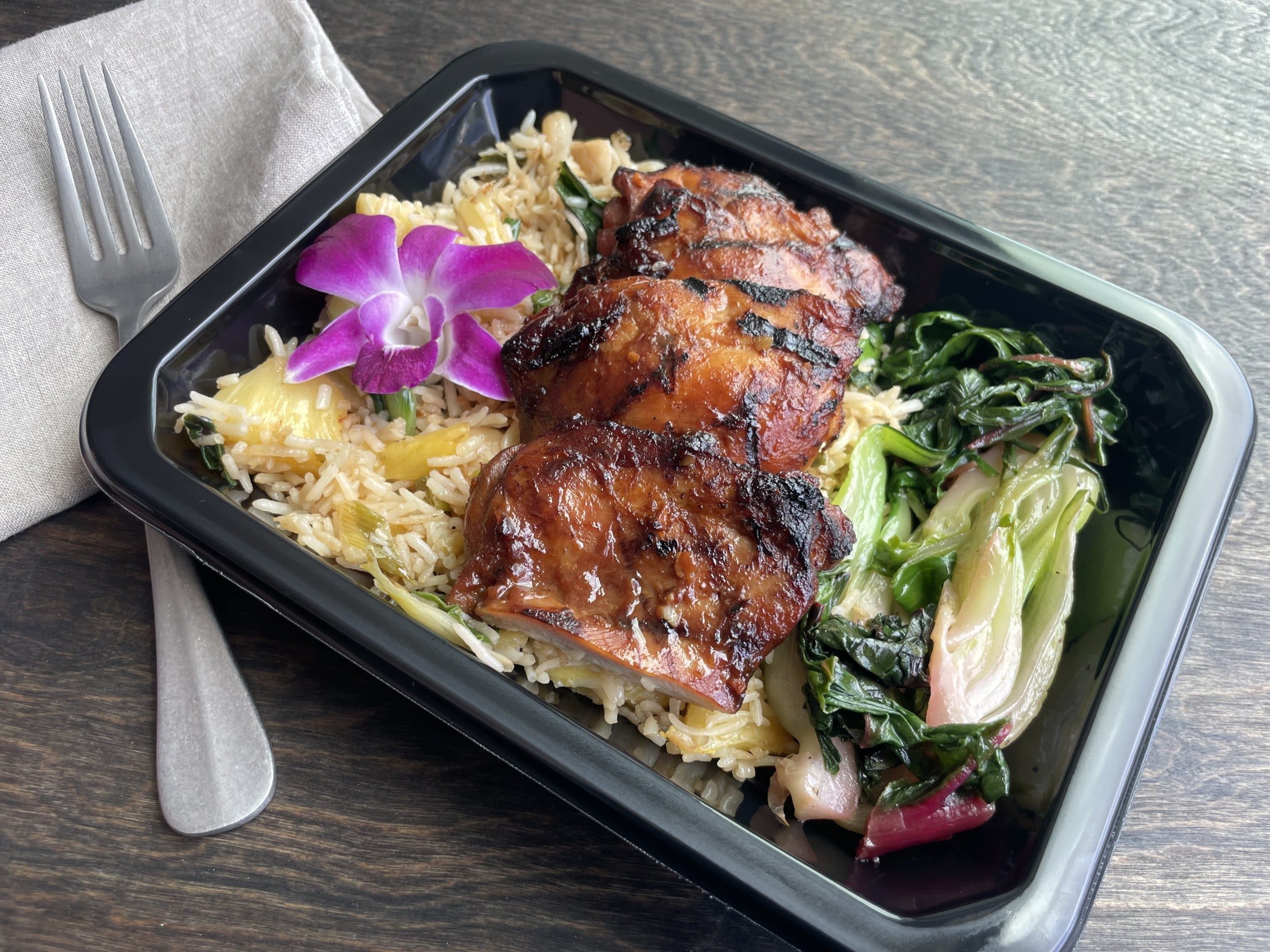
Take your tastebuds on a Hawaiian Vacation
Summer just got here, and this heat already has us dreaming of a sweet island getaway. That’s why this month we turned to the beautiful
Cart
No products in the cart.
NEW YEAR SALE ENDS IN
Spend $130, Save $15. Spend $170, Save $20. Spend $200, Save $30.
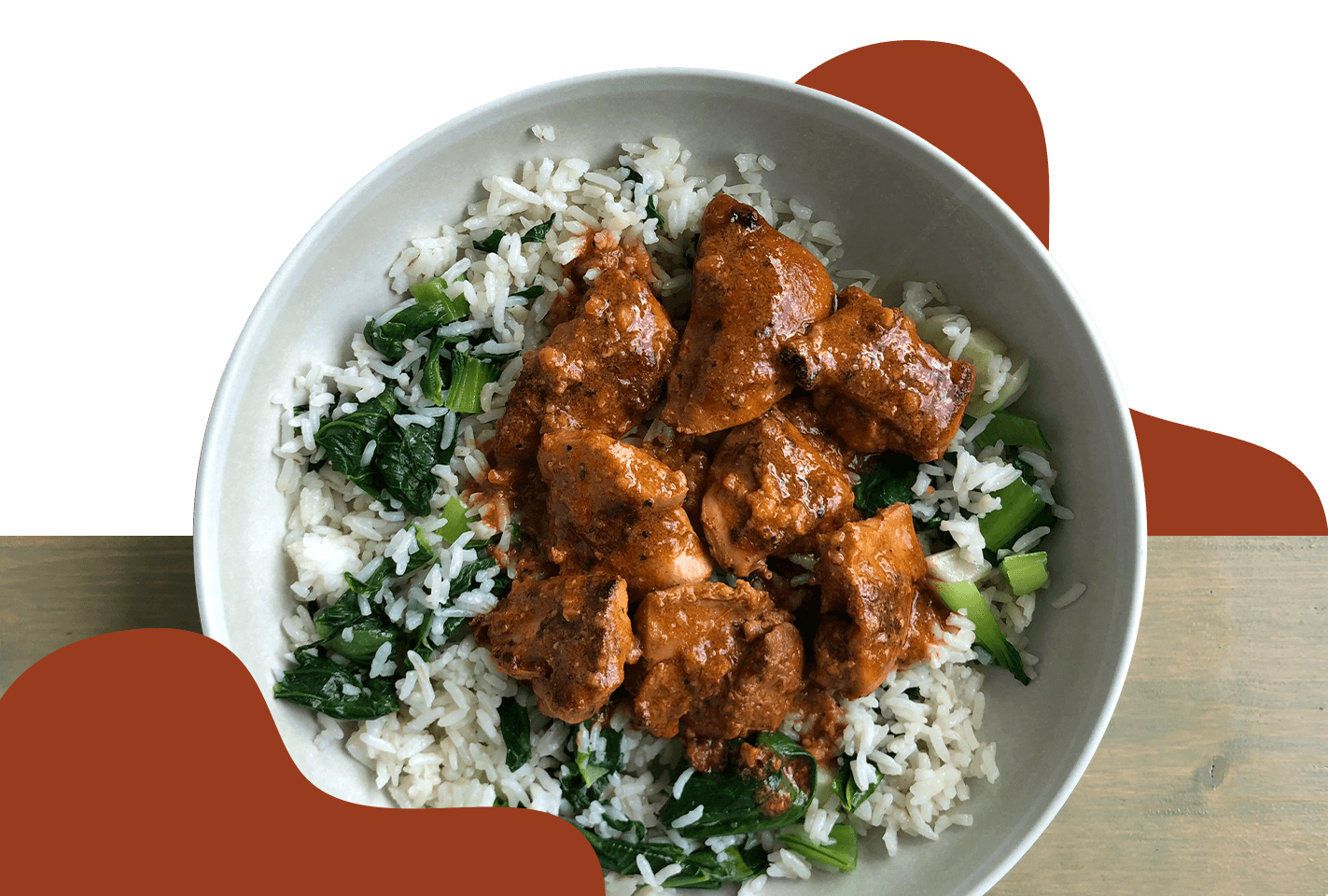
Asian cuisines have been part of the American landscape for decades. However, only in recent years have Filipino dishes started gaining recognition outside immigrant communities. This is surprising because Americans of Filipino heritage now make up one in five of all Asian-Americans, second only to Chinese in number. In addition, the largest percentage of immigrants serving in the United States military were born in the Philippines. Even Cristeta Comerford, the longstanding White House Executive Chef since 2005, is of Filipino descent. So why did Filipino cuisine remain in obscurity for so long and how come it is finally attracting attention?
The Philippines, named after King Philip II of Spain, is one of the world’s largest archipelago nations. It is situated in Southeast Asia in the western Pacific Ocean and comprises some 7,100 islands and islets lying about 500 miles (800 km) off the coast of Vietnam. The islands form three main geographical areas, Luzon, Visayas and Mindanao, while Manila is its capital. The islands may look tiny on a map, but they are home to over 108 million residents. Interestingly, they also house three of the world’s largest shopping malls, the world’s primary supply of nurses, and are one of the world’s largest suppliers of coconuts.
With topography consisting of mountainous terrains, dense forests, plains, and coastal areas, the Philippines is rich in biodiversity. In fact, it is one of eighteen mega-biodiverse countries in the world, containing two-thirds of the earth’s biodiversity. This amounts to between 70% and 80% of the world’s plant and animal species ranking the region fifth overall in the number of plant species.
What does this mean for Filipino cuisine? Such biodiversity supplies a bounty of unique native ingredients that makes Filipino cuisine distinctive. For example, the alluring sounding “Alibangbang Tree” only grows wild in a mountainous region accessible by tribesmen. Also known as an Orchid Tree, the Alibangbang has many benefits not only for insects, but also the community. Its bark is used to make ropes and young leaves are used to flavor meat and fish.

Kalamansi is a citrus fruit used to add sourness to a dish and tabon-tabon is a tropical fruit used by pre-colonial Filipinos as an anti-bacterial ingredient which also takes the fishy smell out of raw fish used in the local Filipino version of ceviche. The country also cultivates different type of nuts such as the pili nut, of which the Philippines is the only known exporter of edible varieties. It is usually made as a merienda (a light morning or afternoon snack) or is incorporated in other desserts to enhance the flavor due to the milky texture it gives off as it melts in the mouth. Locally sourced Sukang Tuba (coconut sap vinegar) is another very common ingredient used in and adapted for various dishes.
Filipino cuisine is the ultimate fusion food; the melting pot of so many different cultures leaving their mark over the last few thousand years. The location of the Philippines in the South China Sea has always been strategically important, making it the focal point of trade and migration dating back to Malayo-Polynesians in around 3,000 BC. The Malayo-Polynesians were the first settlers in the archipelago, responsible for bringing the top staple ingredient to the Philippines: rice.
Referred to as “palay”, rice is traditional staple food in the Philippines. It is the primary crop on most Philippine farms and grows more than other single crop because it has few environmental restrictions. The Central Luzon and Cagayan Valley are the major rice growing regions and the Philippines is a top ten rice producing nation. It follows that rice is integral to Filipino cuisine and diet.
Present in every household and consumed by about seventy-five percent of the population, rice is present at almost every meal. Because of its plain, starchy flavor, it pairs well with a lot of salty and sour local dishes. Filipinos love rice so much that they will eat it any style – traditionally cooked white rice (kanin), burnt rice (tutong), left-over rice (bahaw) or fried rice (sinangag).
The Banaue Rice Terraces (Filipino: Hagdan-hagdang Palayan ng Banawe) are terraces that were carved into the mountains of Banaue, Ifugao, in the Philippines, by the ancestors of the indigenous people. The terraces are occasionally called the “Eighth Wonder of the World.

Three hundred years of Spanish rule had a strong influence on Filipino cuisine. The Spanish brought with them many foods that the Filipinos adopted into their diet: Corn, flour, squash, avocado, sausage, beef, guava, sapodilla (chico fruit), papaya, cabbage, cocoa, potatoes (white), ham, coffee, beer, bread (made from wheat flour), pickles, sardines. The Spanish also introduced forks, spoons, plates, and cups to the Philippines and new methods of cooking such as sautéeing and braising. Forks and spoons are still customary rather than chopsticks – but not knives. However, some Filipinos still prefer to eat the truly native Filipino way, without any utensils.
Subsequent prominent settlers who left their mark in the Philippines included the Chinese and the Americans. The Chinese brought with them soy sauce, bean sprouts, tofu, bamboo shoots, lemongrass, fish sauce and noodles and the Americans brought with them hot dogs, hamburgers, fried chicken and the idea of convenience food. Early Chinese settlers in Manila helped to develop pancit (noodles) and lumpia (spring rolls).
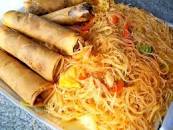
Indigenous Filipino food (also known as “pinoy” cooking ) is somewhat similar to Indonesian and Malaysian food but often has a distinctive sour taste made from a mixture of vinegar and unripe tamarind seeds. While Chinese and Spanish feature most prominently during holidays and feasts, native Filipino food is the peasant rural food of farmers and fishermen. Filipino cuisine is probably the least spicy of all Asian cuisines except in one or two provinces because the colonial mixture has diluted it. Most main dishes are stews of chicken, pork, fish or seafood. Common spices and flavoring include vinegar, patis (a very salty, fermented fish sauce condiment), bagoong (pungent shrimp paste), banana ketchup, lemon, coconut milk, chilies, bay leaves and garlic.
Chicken adobo is the unofficial national dish of the Philippines. It also exemplifies how the country is such a rich melting pot of different historical influences. In essence, adobo is a protein (usually chicken, pork or fish) that is braised in vinegar then mixed with other herbs/spices. Adobo comes from the Spanish verb “adobar” which means “to marinate. Upon arrival, the Spanish noticed locals using vinegar and salt to marinate the chicken, pork and fish. They embellished this by adding ingredients they brought with them like garlic and onions. Over time Chinese soya sauce replaced the salt and other common ingredients like bay leaves and peppercorns. This was a traditional way of cooking meat because the acid from the vinegar and high salt content of the soya sauce created a perfect preservative.
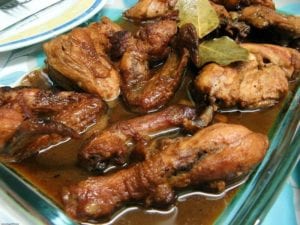
This popular Filipino oxtail stew simmers nice and slowly with peanut butter. The dish includes annatto seeds for flavor, and which gives it its vibrant yellow-orange color. Kare-kare is usually only cooked on very special occasions because preparing it can be time consuming. The process starts with tenderizing the ox tail, beef, and (sometimes) ox tripe for almost two hours. It is then cooked with ground peanuts and creamy peanut butter, seasoned with fish sauce, and finished off with bok choy, string beans, and eggplants. Kare-kare is a real crowd pleaser as its nutty-sweet and savory flavors excite the taste buds with an explosion of flavors. This dish has to be eaten with rice, otherwise the flavors can be overwhelming.
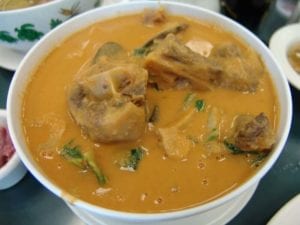
Lechon, derived from the Spanish word for “roasted suckling pig”, is probably the most popular dish of the country. It is traditionally the star of any festive occasion, from Christmas to birthdays and local festivals. Lechon is definitely a mouthwatering showstopper. The art of roasting Lechon starts with marinating the pig in salt, pepper, soy sauce, or coconut water for a few days before stuffing it with aromatics such as lemongrass, garlic, tamarind, onions, or chives. It then roasts on a large bamboo spit over an open fire for hours. Once the Lechon is cooked, the skin, which is the best part of the dish, is served with pieces of meat, with white rice on the side. In the United Kingdom it bears similarity to a roast pork meal where the ‘crackling’ (crispy skin) is as much a part of the meal as the meat.

Filipino Spaghetti, also known as Sweet Spaghetti, is similar to the regular spaghetti Bolognese. If you know the movie Elf then maybe this was the inspiration behind his syrupy spaghetti! The ground beef or pork first brown with aromatics and then simmers in tomato sauce and a choice of herbs until thick and hearty. What sets this Filipino favorite apart is the addition of sweet banana ketchup to the meat sauce plus the grated cheddar topping as a garnish. This cult favorite is a very popular dish at most Filipino fast food restaurants and is commonly seen at children’s parties.

Kinilaw is similar to the famous Peruvian dish called ceviche. The word “kinilaw” or “kilaw” means ‘eaten fresh’ in Tagalog. It is a raw fish salad in an acidic juice, usually kalamansi (Filipino lime) and vinegar. In the Philippines, vinegar has the nickname “liquid fire” because it cooks the food enough to be digested. More interestingly, vinegar in the Philippines derives from alcoholic fermentation of coconut water, which is what gives it a sour-sweet flavor. Just like with ceviche, the acid from the lime and the vinegar “cooks” the meat. Other ingredients usually in a kinilaw include garlic, ginger, onion, pepper and chilli.
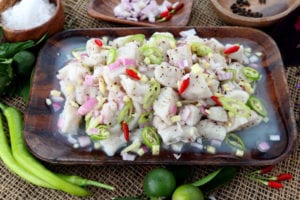
According to Google, Asian cuisine features strongly among the top ten most popular ethnic cuisines. Chinese is the most popular of all ethnic cuisines (including non-Asian). Thai, Japanese, Korean, Vietnamese and Cuban follow in descending order. But where is Filipino? Much further down the list with relatively low visibility. In fact, if you were to ask a friend to name a Filipino dish they would probably be stumped. Why is this the case when Filipino cuisine is so interesting and diverse?
One argument is that it is because Filipino food is ‘indistinguishable’. It is an aggregation of Spanish, Chinese, Malay and American influences. A second argument is that colonization over decades has resulted in loss of national pride – a reduced sense of identity. A third is that Filipino immigrants in America have historically felt a sense of shame or dishonor around their food. They are accustomed to eating foods that are outside mainstream America and regarded as repugnant. Examples include Sisig (parts of pig’s head and chicken liver), Balut (fertilized duck egg), Kamaru (rice field crickets), Tamilok (woodworm) and Adidas (chicken feet).

In the Philippines, the American colonial government set up the public school system. Filipino kids were taught that their local food was unhealthy. They learned that Western dishes and processed food such as canned milk were superior. In reality, Filipinos are resourceful, frugal people who have learned to make the best dishes they can out of locally available ingredients. But when the only representations of your culture available are negative, it’s not surprising that some Filipinos internalize all that shaming.
All that being said, why is Filipino cuisine starting to gain traction in the US? American palettes are becoming more open and adventurous toward food in general. This is due in part to the arrival of food and travel TV shows helping cooking become more of a hobby and less of a chore. The Internet and Cable TV have finally afforded Americans the opportunity to peek outside the box and consider what else might be out there.
We are in an era in which adventurous eating is cool. Grocery stores are stocking all kinds of products that were not available previously without visiting a local ethnic supplier. All in all, it is very good news for the Filipino restaurant community. The opportunity for underrepresented cuisines to find their limelight in American food culture is wide open. Whether it be through innovation, fusion, or standing by tradition, Filipino food has earned a seat at the table.
Have we whetted your appetite for Filipino cuisine? We hope so. We have chosen a dish that is uniquely Filipino but not too far removed from more familiar dishes. Healthy Gourmet’s Adobo Chicken is the unofficial national dish of the Philippines, involving vinegar, garlic, soy sauce and spices. Traditionally mild in spice and tangy, we added a touch of annatto and bay leaves to our recipe. Then simmered the marinade with chunks of chicken thigh, and served it over garlicky fried rice and baby bok choy. Give it a try!
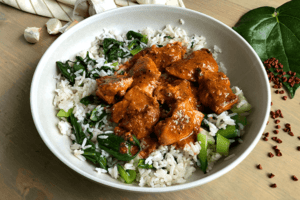

Summer just got here, and this heat already has us dreaming of a sweet island getaway. That’s why this month we turned to the beautiful
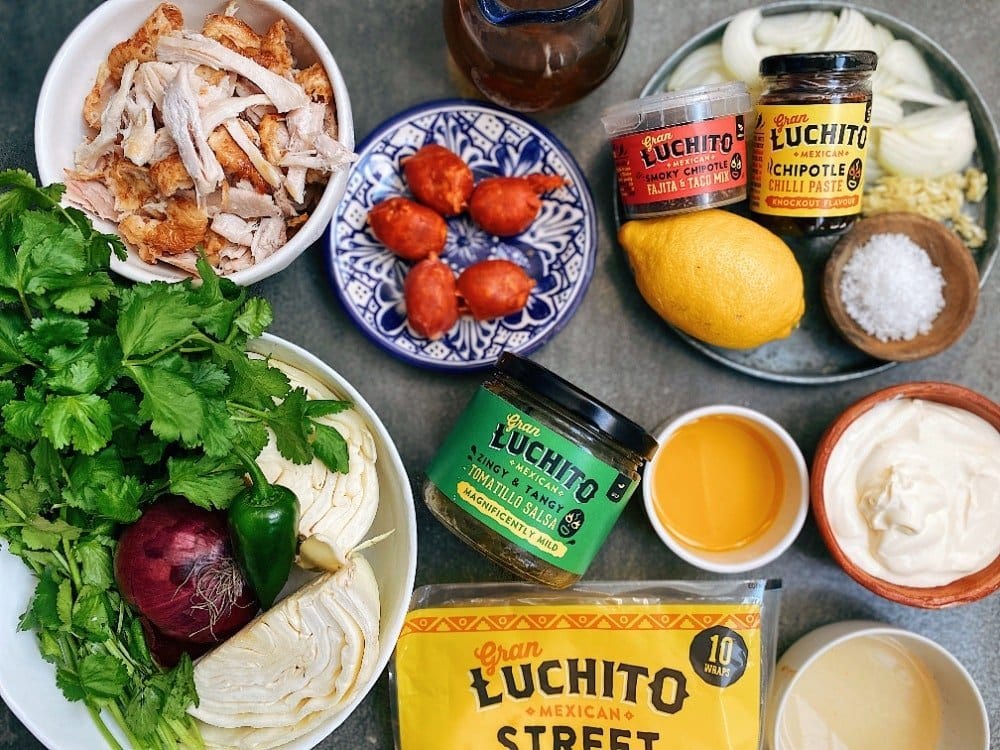
Check out how EatFlavorly utilizes Mexican meats and so many more in our scratch-made meals over at Our Menu! With Cinco de Mayo

National Earth day is approaching on Thursday April 22nd. Today, not only is Earth Day a day meant to increase awareness of environmental problems, but
The convenience of home meal delivery is undeniable. Getting food delivered to your door that does not require cooking or cleaning is a huge time-saver.